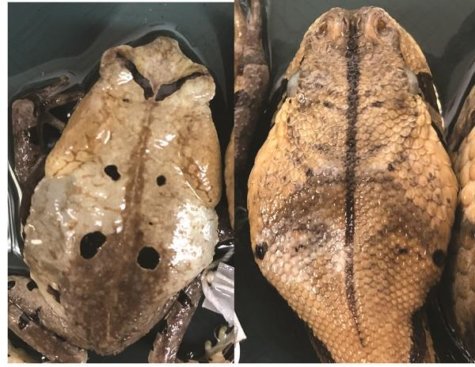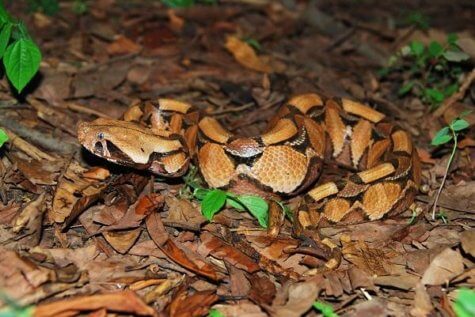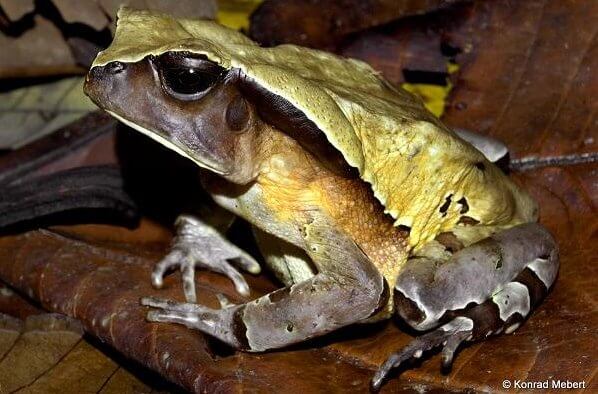EL PASO, Texas — It’s a common theme in nature documentaries and wilderness-based works of fiction, but it still bears repeating: nature is unforgiving, and often times cruel, especially for animals and species unable to adapt to their surroundings. For the vast majority of the world’s animal population, simply surviving each new day is the name of the game. In pursuit of this goal, thousands of different species have developed their own unique survival methods and instincts. Now, a new study has discovered a particular African toad that evolved to appear very similar to one of the continent’s largest and most venomous vipers.
Besides just looks, the Congolese giant toad is even capable of imitating the viper’s movements and noises. Researchers believe the species may use its striking resemblance to the super venomous Gaboon viper to actually avoid attacks from the snake. The term “may” is added here because this variety of toad is extremely rare, and no one has actually seen an interaction between the two species in the wild.
The Gaboon viper has the longest fangs of any snake in the world, and produces more venom than any other viper. With all that in mind, the giant toads probably made a very good decision in adapting to mimic them.

“Our study is based on ten years of fieldwork and on direct observation by researchers lucky enough to see the toad’s behavior first-hand. We’re convinced that this is an example of Batesian mimicry, where a harmless species avoids predators by pretending to be a dangerous or toxic one,” explains Dr. Eli Greenbaum from the University of Texas at El Paso in a release. “To fully test our hypothesis, we’d have to demonstrate that predators are successfully duped, but this would be very difficult in the wild, where the toads are only encountered rarely. However, based on multiple sources of evidence provided in our study, we are confident that our mimicry hypothesis is well-supported.”
Using wild-caught, captive, and museum-preserved specimens, the research team compared the markings of both animals. They noted that both the color pattern and markings on the toad’s body matched the viper’s head. These similarities are highlighted by matching dual dark brown spots, a dark brown stripe down the toad’s back, and the toad species’ oddly smooth skin for a toad.
The Congolese giant toad’s uncanny resemblance to the super predator has an added benefit as well; other predators likely mistake the toads for the vipers regularly, and avoid making contact.

Amazingly, these toads can also imitate the viper’s distinctive attack call. Whenever a Gaboon viper feels threatened, it tends to give off a long, loud warning hiss before pouncing on whatever is bothering it. Herpetologists have observed Congolese giant toads making very similar sounds. There is even one reported sighting, albeit over a century ago, of a Congolese giant toad actually mimicking the cocked head of a viper threatening to attack.
Finally, the study’s authors say that location is another important aspect of the toad’s survival strategy. Of course, these toad’s distinctive markings and abilities are only useful in areas inhabited by both Gaboon vipers and other predators familiar with the viper species’ appearance and tendencies. Sure enough, after investigating reported sightings in the Democratic Republic of Congo, researchers noted that the giant toads only appear to be present in areas where Gaboon vipers live as well.
It’s estimated that both animal species first evolved at around the same time period, about four or five million years ago.
“Given the relatively large size and therefore calorific value of this toad compared to other species, it would make tempting prey to a large variety of generalist predators, including primates and other mammals, lizards, snakes and birds,” says Chifundera Kusamba, from the Centre de Recherche en Sciences Naturelles. “Many of these predators use vision to find their prey, and because the viper is deadly venomous, they probably recognise the distinctive, contrasting markings from a considerable distance and avoid the toad because of them, receiving a threatening hiss if the appearance doesn’t put them off.”
The study is published in the Journal of Natural History.
